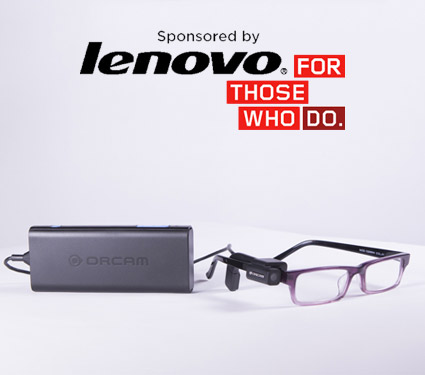
By Gary M. Kaye
Chief Content Officer, Tech50+ (www.tech50plus.com)
For all too many of us, impediments that were once annoyances turn into truly challenging disabilities as we age. For many years we’ve been hearing that one day technology could really help overcome low vision or blindness, hearing loss, or loss of mobility. And now there are some breakthrough technologies that prove if you have a disability you don’t need to succumb, you can overcome.
Delivering on the ‘Google Glass’ promise
Advances in computer vision and artificial intelligence are behind a product called OrCam, launched this past month by an Israeli firm of the same name. The OrCam looks very much like Google Glass, but that’s where the similarity ends. A small camera clips onto your eyeglasses and uses a bone conduction earpiece so you can hear what it has to say. In the future you'll be able to connect to a hearing aid. A wire connects to a pocket-sized computing device that can be clipped to a belt or put in a pocket.
I had an opportunity to try OrCam out and found it pretty simple to use. You turn your head in the general direction of what it is you wish to read, be it a newspaper, a sign, a menu, cereal box, whatever. You then use your finger and point to what you want to read and OrCam begins reading in your ear.
It uses a combination of technologies including computer vision, optical character recognition and facial recognition. Initially it will be able to store 150 objects that you teach it to recognize – for example your favorite brand of cereal – or a household item like hand soap. Eventually the library will be expanded. When you run across someone you interact with, you can “teach” OrCam to recognize the face. So the next time you encounter that person, OrCam will say the name. OrCam is planning to include the ability to recognize places you frequent, like a Starbucks.
One unit does it all
OrCam does not require any kind of broadband, WiFi, or Bluetooth connection in order to operate. It does not rely on connectivity to a smartphone or to the cloud. There's good reason for that. First, it means that you never have to worry about access to a cell signal. It also means that response time can be almost instantaneous. You don’t have to wait for information to get sent up to the cloud and then sent back. Thirdly, it means the system is secure. And finally, there’s the issue of power. Using a device to connect with the cloud requires power, and OrCam already draws a fair bit of juice. If you use it intermittently, one charge will last you the better part of a 12 to 14-hour day. Heavy use could cut that down to only three or four hours – say if you’re reading a book or a newspaper.
OrCam comes with a micro-SD card that allows the company to make firmware and software updates and simply send the card out to its users. While the initial release is quite impressive, you can expect that future upgrades may include larger memories, bigger libraries, and even some additional functionality such as GPS. Dr. Yonatan Wexler, OrCam’s senior vice president of R&D tells me that another feature under development is visual context. You’ll be able to walk into a room and OrCam will be able to tell you something like, “there are three people having a conversation.” But Wexler admits there are still some significant technology challenges to overcome before that can be implemented.
Hands-on training available
OrCam is being sold directly by the company. Initially, it will be rolled out in about 20 markets including Massachusetts. OrCam is fielding a team of 25 trainers across the U.S., so if a customer is interested, they can call OrCam at 1-800-713-3741 and see if there’s someone within a couple of hours drive. When you buy OrCam, it is delivered by a trainer who will spend several hours with the user. There is a learning curve involved. Rami Ben-Yehuda, OrCam’s vice-president for sales tells me that it generally takes about two weeks for a user to get really comfortable with the device. And while it can be used by someone who is totally blind, it is better suited for those who have at least some vision.? According to some early customers with deteriorating eyesight or who have been blind since birth, the experience of using OrCam is life changing. It makes window shopping possible. Reading a newspaper becomes a pleasure and not a daunting challenge. OrCam’s initial price is $3,500. Other desktop reading machines on the market– like the Smartview Synergy series – sell for as much as $3000. For those who are blind or suffer from low vision, OrCam promises to be a disruptive technology that delivers on what many of us thought might be the promise of Google Glass.
Gary Kaye is the creator of Tech50+ (www.tech50plus.com), the leading website covering technology from the Baby Boomer perspective. Kaye has been covering high tech for more than 30 years with outlets including NBC, ABC, CNN and Fox Business. He is a regular contributor to AARP and other websites on issues regarding the nexus of technology, seniors and baby boomers.